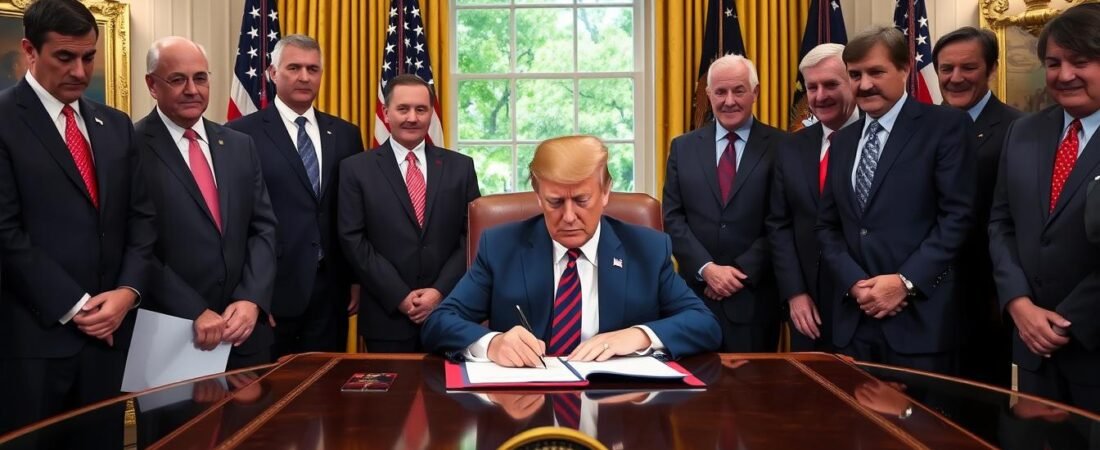President Trump’s “One Big Beautiful Bill” has now become law, bringing sweeping changes to America’s tax code and federal spending priorities. This landmark legislation promises to reshape the economic landscape for years to come. But who really benefits? Our analysis breaks down the economic winners and losers across different income brackets, examining both immediate tax implications and long-term budget consequences.
Understanding Trump’s Big Beautiful Bill Economic Impact
The One Big Beautiful Bill Act (OBBBA) represents one of the most significant economic policy shifts in recent years. The legislation makes permanent the 2017 Trump tax cuts while adding new provisions for seniors, families, and businesses. It also implements substantial changes to federal spending, particularly in social safety net programs like Medicaid and SNAP (food stamps).
Economic analysts are divided on the bill’s long-term impact. Supporters argue it will drive economic growth through tax relief and reduced regulation. Critics contend it disproportionately benefits higher-income Americans while potentially increasing the federal deficit. Our analysis examines these claims through the lens of different income groups.
Key Economic Provisions of the One Big Beautiful Bill
| Key Provision | Description | Primary Beneficiaries |
| Tax Cut Extensions | Makes 2017 tax cuts permanent | All income groups, with larger percentage benefits to higher earners |
| Senior “Bonus” Deduction | $6,000 deduction for Americans 65+ | Middle-income seniors |
| SALT Deduction Increase | Cap raised from $10,000 to $40,000 | Upper-middle and high-income taxpayers in high-tax states |
| Tip Income Deduction | Up to $25,000 deduction on qualified tip income | Service industry workers |
| Medicaid Funding Cuts | Approximately $1 trillion reduction | Federal budget (cost savings) |
| SNAP Benefit Changes | Expanded work requirements | Federal budget (cost savings) |
Economic Impact on Low-Income Americans (Bottom 20%)

Potential Benefits
- Child tax credit increase to $2,200 per child (up from $2,000)
- Tax deduction for tip income up to $25,000 benefits service workers
- Overtime pay deduction of up to $12,500 for eligible workers
- “Trump accounts” with $1,000 federal deposit for newborns
Potential Drawbacks
- Medicaid work requirements could lead to coverage loss for 7.8 million
- SNAP work requirement expansion affects adults 55-64 and parents with children 14+
- Elimination of certain exemptions for veterans, homeless, and foster youth
- Reduced funding for social safety net programs
According to Yale Budget Lab analysis, the lowest-income Americans may experience a net economic loss under the One Big Beautiful Bill. While tax deductions for tip income and overtime pay provide some relief for working individuals, the most vulnerable populations face potential benefit reductions from changes to Medicaid and SNAP eligibility requirements.
The expanded child tax credit offers modest help to families with children, but the full benefit may not reach the lowest-income households who don’t earn enough to claim the entire non-refundable portion. The Congressional Budget Office estimates that approximately 5.3 million families could lose at least $25 in monthly SNAP benefits, with an average reduction of $146 per month.
Economic Impact on Middle-Income Americans (Middle 60%)

Potential Benefits
- Permanent extension of 2017 tax cuts
- Increased standard deduction ($15,750 single/$31,500 married)
- Senior “bonus” deduction of $6,000 for those 65+
- Auto loan interest deduction up to $10,000
- Expanded child tax credit and overtime pay deduction
Potential Drawbacks
- Elimination of clean energy tax credits after 2025
- Potential increases in healthcare costs
- New student loan repayment plan could increase monthly payments
- Possible long-term impact from increased federal deficit
Middle-income Americans see mixed results from the One Big Beautiful Bill. The permanent extension of the 2017 tax cuts provides continued relief, with the average middle-income family seeing tax savings of approximately $1,300 per year according to Treasury Department estimates.
The senior “bonus” deduction particularly benefits middle-income retirees, effectively offsetting taxes on Social Security benefits for many. However, the elimination of clean energy tax credits could increase costs for those looking to install energy-efficient home improvements or purchase electric vehicles.
The auto loan interest deduction offers modest benefits for new car buyers, though economic analysts suggest the actual savings will typically be under $500 in the first year for most middle-income households.
Economic Impact on High-Income Americans (Top 20%)

Potential Benefits
- Permanent extension of 2017 tax cuts with favorable top rates
- Increased SALT deduction cap from $10,000 to $40,000
- Permanent Section 199A pass-through business deduction
- Increased estate tax exemption ($15M single/$30M married)
- Qualified small business stock exclusion increased to $15M
Potential Drawbacks
- SALT deduction benefits phase out above $500,000 income
- Potential long-term economic impact from increased federal deficit
- Market volatility during implementation phase
High-income Americans generally see the most substantial benefits from the One Big Beautiful Bill. The permanent extension of the 2017 tax cuts maintains favorable top tax rates, while the increased SALT deduction cap provides significant relief for those in high-tax states who were previously limited to $10,000 in deductions.
Business owners benefit from the permanent extension of the Section 199A pass-through deduction, which allows eligible businesses to deduct up to 20% of qualified business income. Wealthy families also gain from the increased estate tax exemption, which shields substantially more assets from taxation.
According to Treasury Department analysis, taxpayers in the top 1% income bracket could see average tax savings of approximately $50,000 annually under the legislation. The increased qualified small business stock exclusion, which allows investors to claim up to $15 million in tax-free income from certain startup investments, primarily benefits high-net-worth individuals.
Budget Implications and Economic Outlook
The Congressional Budget Office (CBO) and the White House offer starkly different projections of the One Big Beautiful Bill’s impact on the federal budget. The CBO estimates the legislation could increase the federal deficit by approximately $3.5 trillion over the next decade, primarily due to the permanent extension of tax cuts without offsetting revenue increases.
The White House counters that the bill will reduce deficits by over $2 trillion through economic growth and program savings. This projection relies on optimistic assumptions about GDP growth rates averaging 3.5% annually over the next decade, significantly higher than the CBO’s projection of 1.8% average growth.
| Economic Metric | CBO Projection | White House Projection |
| 10-Year Deficit Impact | +$3.5 trillion | -$2.1 trillion |
| Average Annual GDP Growth | 1.8% | 3.5% |
| Job Creation (10 Years) | 1.2 million | 4.8 million |
| Wage Growth (Annual) | 0.5% | 1.7% |
Independent economists generally project outcomes between these two extremes. The Penn Wharton Budget Model estimates the legislation will increase the deficit by approximately $2.8 trillion over ten years, with modest economic growth benefits partially offsetting the revenue losses from tax cuts.
Expert Economic Analysis and Long-Term Projections
Economic experts remain divided on the long-term implications of the One Big Beautiful Bill. Supply-side economists argue that the tax cuts will stimulate business investment and economic growth, eventually generating enough additional revenue to offset initial losses. They point to increased business confidence and stock market gains as early indicators of success.
Critics counter that the bill follows a familiar pattern of tax cuts that primarily benefit higher-income Americans while creating budget pressures that eventually lead to cuts in programs serving lower-income groups. They note that similar claims about the 2017 tax cuts generating enough growth to pay for themselves did not materialize.
“The economic impact of the One Big Beautiful Bill will likely vary significantly across income groups and regions. While the tax provisions offer immediate benefits to many Americans, the long-term fiscal implications and program changes create a complex picture that defies simple characterization as either entirely positive or negative.”
Regional impacts will vary considerably. Residents of high-tax states like New York, New Jersey, and California benefit from the increased SALT deduction cap. Rural communities may see mixed results, with tax benefits for farmers and small businesses potentially offset by changes to healthcare access and federal program funding.
Income Group Comparison: Winners and Losers
| Income Group | Average Tax Change | Benefit Program Impact | Net Economic Effect |
| Bottom 20% ( | -$100 to -$300 | Potential benefit reductions of $500-$1,800 annually | Net loss of $200-$1,700 annually |
| Lower-Middle 20% ($30,000-$55,000) | -$400 to -$800 | Minimal to moderate benefit changes | Net gain of $200-$700 annually |
| Middle 20% ($55,000-$90,000) | -$900 to -$1,500 | Minimal benefit changes | Net gain of $800-$1,400 annually |
| Upper-Middle 20% ($90,000-$170,000) | -$1,800 to -$3,200 | Minimal benefit changes | Net gain of $1,700-$3,100 annually |
| Top 20% (>$170,000) | -$5,000 to -$50,000+ | No significant benefit changes | Net gain of $5,000-$50,000+ annually |
This comparative analysis reveals a clear pattern: the economic benefits of the One Big Beautiful Bill generally increase with income level. While all income groups see some tax reductions, the magnitude increases substantially for higher earners. Meanwhile, potential benefit reductions primarily affect lower-income Americans.
The bottom 20% of earners may experience a net economic loss when accounting for both tax changes and benefit program modifications. Middle-income groups generally see modest net gains, while the top income quintile receives the most substantial benefits both in dollar terms and as a percentage of income.
Conclusion: Navigating the Economic Impact

The One Big Beautiful Bill represents a significant shift in America’s economic policy landscape. Its impact varies substantially across income groups, with the most substantial tax benefits flowing to higher-income Americans while program changes primarily affect lower-income groups.
For individual Americans, understanding how these changes affect your specific financial situation is crucial. Tax provisions like the permanent extension of the 2017 cuts, the senior bonus deduction, and changes to SALT caps may provide meaningful benefits depending on your circumstances. Meanwhile, changes to programs like Medicaid and SNAP could affect eligibility and benefits for those who rely on these services.
The long-term economic and budget implications remain uncertain, with projections varying widely based on assumptions about economic growth, behavioral responses to tax changes, and implementation details. What’s clear is that the legislation represents a substantial bet on supply-side economics, with significant implications for federal revenues and spending priorities for years to come.
Stay Informed About Economic Policy Changes
Economic policy affects your financial future. Subscribe to our free newsletter for ongoing analysis of policy changes, practical financial advice, and strategies to optimize your personal finances in this evolving economic landscape.
